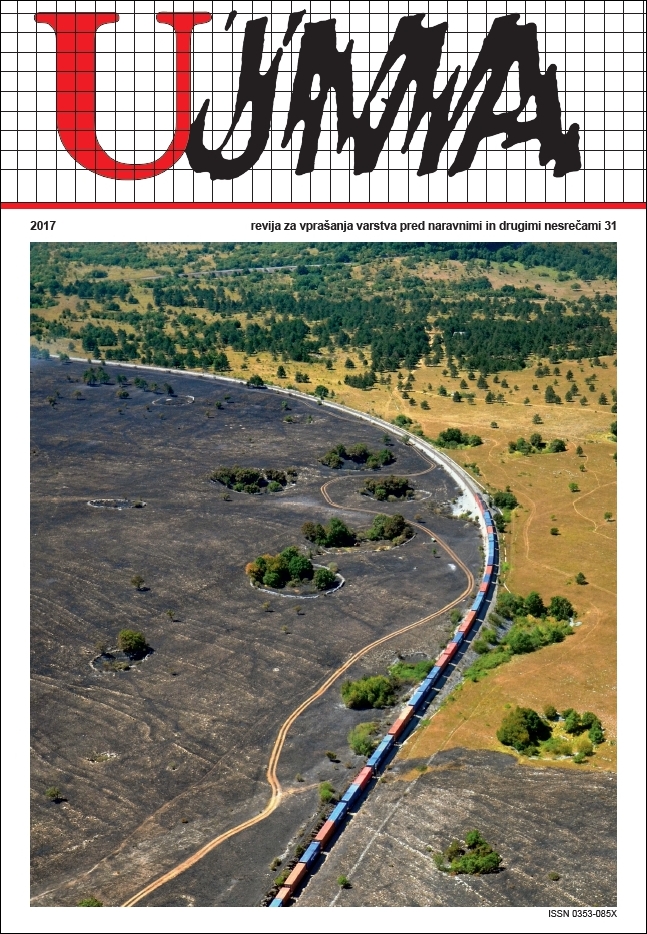EARTHQUAKE INDUCED LIQUEFACTION OF SEDIMENTS
Abstract
Liquefaction is a dangerous effect of strong earthquakes which can locally result in great damage to buildings and many casualties. Liquefaction occurs if grained and saturated unconsolidated sediments are exposed to dynamic stress, which causes cyclic dynamic deformations and the collapse of the loose internal structure and shear strength. The mechanism is very complex and thus the subject of intense investigations which lead to better understanding. Of the methods used to evaluate the liquefaction hazard, the most important are in-situ tests in boreholes and the empirical relationship between geomechanic parameters and liquefaction susceptibility. Such evaluations are part of seismic microzonation studies. Although up to now there has been no proven case of liquefaction in Slovenia, it is necessary to include it in seismic hazard assessments.
References
Ansal, A. 2004. Recent advances in earthquake geotechnical engineering and microzonation. Kluwer Academic Publishers, Dordrecht, 354 str.
Bramerini, F., Castenetto, S., Naso, G., 2015. Guidelines for Seismic Microzonation. Conference of Regions and Autonomous Provinces of Italy – Civil Protection Department. Rome, 120 str.
Gosar, A., 2012. Application of Environmental Seismic Intensity scale (ESI 2007) to Krn Mountains 1998 Mw = 5.6 earthquake (NW Slovenia) with emphasis on rockfalls. Nat. hazards earth syst. sci., 12/5, 1659–1670.
Guerrieri L., Vittori E., 2007. Intensity scale ESI 2007. Mem. Descr. Carta Geologica d'Italia, 74. Servicio Geologico d'Italia, APAT, Rome, 41 str.
Lapajne, J., 1995. Potres v Kobeju januarja 1995 – seizmološke in seizmotektonske značilnosti. Ujma, 9, 131–135.
Lenart, S., 2006a. Numerični model za račun pornega tlaka v zemljinah z visokim potencialom likvifakcije. Doktorska disertacija, Univerza v Ljubljani, FGG, 302 str.
Lenart, S., 2006b. Deformation characteristics of lacustrine carbonate silt in Julian Alps. Soil dynamics and earthquake engineering, 26/2–4, 131–142.
Lenart S., Koseki J., Miyashita Y., 2012. Soil liquefaction in the Tone river basin during the 2011 earthquake off the Pacific coast of Tohoku. Acta geotechnica Slovenica, 9/1, 4–15.
Petkovšek A., 2000/2001. Geološke geotehnične raziskave plazu Stože. Ujma, 14–15, 109–117.
Reiter, L., 1990. Earthquake hazard analysis. Columbia University Press, New York, 253 str.
Smolar J., Maček M., Petkovšek A., 2012. Raziskave občutljivosti peskov na krškem polju na utekočinjenje. Razprave 6. posvetovanja slovenskih geotehnikov Lipica, 14. do 15. junij 2012.
Youd, T. L., 1984. Geological effects – liquefaction and associated ground failure. USGS Open-File Report 84-760, Menlo Park, 210–232.
Youd, T. L., 2003. Liquefaction mechanisms and induced ground failure. V: Lee in sod (ur.): International handbook of Earthquake and Engineering Seismology. Academic Press, Amsterdam, 1159–1173.
Wikipedia: Soil liquefaction. https://en.wikipedia.org/wiki/Soil_liquefaction
Žlender B., Lenart S., 2005. Cyclic liquefaction potential of lacustrine carbonate from Julian Alps. Acta geotechnica Slovenica, l/2, 22–3.
Downloads
Published
Issue
Section
License

This work is licensed under a Creative Commons Attribution-NonCommercial-NoDerivatives 4.0 International License.
The articles are made available to the public under Creative Commons Attribution-NonCommercial-NoDerivatives 4.0 International (CC BY-NC-ND 4.0).


